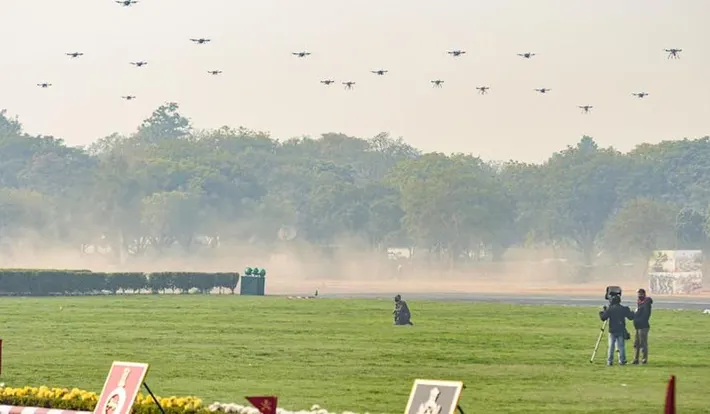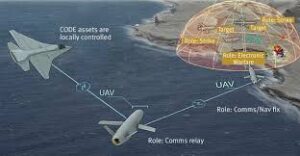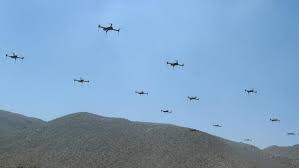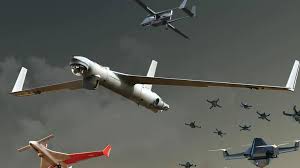What is a Drone Swarm Technology and How does It Works

Drone swarm technology enables groups of drones to work together in a coordinated manner, often operating autonomously without direct human control. These technologies have the potential for various civilian applications, such as combating wildfires and locating missing individuals.
The swarm of drones holds potential in various fields, including military operations, disaster management, agriculture, infrastructure inspection, and entertainment. Ongoing research and development are focused on refining swarm algorithms, improving communication protocols, and exploring new applications for this technology.
What is a Drone Swarm Technology

Drone swarm technology is a fascinating advancement that brings together multiple drones to work in a coordinated manner. These swarms can operate autonomously or under central control, achieving common goals through seamless coordination. Here’s what you need to know about them:
- Definition:
- A drone swarm is a collection of drones that collaborate to accomplish tasks. They leverage advanced algorithms to adapt to changing environments and objectives.
- These swarms can consist of hundreds or even thousands of drones working together 2.
- How Drone Swarms Work:
- The concept of drone swarms was inspired by observing natural swarms of insects like bees.
- Replicating swarm behavior in robotics (and consequently, drones) is challenging due to the immense processing power required.
- Advancements in technology now allow hundreds of drones to fly autonomously.
- Onboard cameras and proximity sensors play a crucial role:
- Cameras provide visual information, enabling drones to navigate and maintain formation.
- Proximity sensors help drones detect each other’s presence and avoid collisions.
- Without these technological advancements, mesmerizing drone shows like those at the Super Bowl or Olympics would have been impossible.
- Applications:
- Entertainment: Drone swarms have dazzled audiences worldwide during events like the Olympics, Disney World shows, and Lady Gaga’s performances.
- Civilian Uses:
- Wildfire Fighting: Coordinated swarms can monitor and combat wildfires.
- Search and Rescue: Swarms aid in locating missing persons.
- Surveillance: Urban surveillance and monitoring of large areas become more efficient.
- Military: Drone swarms offer tactical advantages, such as reconnaissance and coordinated attacks
How does Swarm Drown Technology Work?
Drone swarms employ advanced computer algorithms, local sensing, and communication technologies to synchronize multiple drones towards a common objective. These swarms can utilize different command and control methods, such as preprogrammed missions, centralized control from a ground station or control drone, or distributed control where drones communicate and collaborate based on shared information. They can also incorporate swarm intelligence, drawing inspiration from the collective behaviors seen in insect colonies and bird flocks, and leverage artificial intelligence techniques to train the swarms to adapt to novel or unforeseen circumstances.
Swarm Drones Technology Opportunities
- Agriculture: Drone swarms have the potential to assist in planting seeds, monitoring crop health, detecting disease outbreaks, and applying treatments like fertilizers to crops.
- Emergency Management: Drone swarms can aid in locating missing individuals, providing emergency care and supplies during natural disasters, and assisting firefighters in tracking and controlling wildfires while gathering valuable information.
- Entertainment: Drone swarms offer an alternative to traditional fireworks displays, providing visually stunning aerial performances without the associated risks of debris, pollution, fires, and disruptions to both animals and humans.
Swarm Drones Technology Challenges
Drone swarm technology presents exciting possibilities, but it also faces several challenges. Let’s delve into some of these hurdles:
- Communication and Coordination:
- Ensuring efficient communication and coordination among individual drones within a swarm is crucial.
- Achieving seamless collaboration while avoiding collisions or redundancy is a complex task.
- Efficient Power Utilization:
- Drone swarms require power to operate, and optimizing energy usage is essential.
- Balancing flight time, payload, and computational demands is a challenge.
- Obstacle Avoidance:
- Navigating around obstacles—whether natural or man-made—requires sophisticated algorithms.
- Real-time obstacle detection and avoidance are critical for safe swarm operation.
- Safety and Security:
- Ensuring the safety of people, property, and other aircraft is paramount.
- Robust fail-safes, collision avoidance, and secure communication protocols are necessary.
- Regulatory and Legal Issues:
- Operating drone swarms within existing regulations can be challenging.
- Compliance with airspace rules, privacy laws, and liability considerations is vital.
- Ethical Considerations:
- Ethical dilemmas arise, especially in scenarios involving surveillance or military applications.
- Striking a balance between utility and privacy is essential.
- Interference and Jamming:
- External interference (e.g., radio frequency jamming) can disrupt swarm communication.
- Robustness against intentional or unintentional interference is critical.
- Limited Payload Capacity:
- Smaller drones have restricted payload capacity due to their size and weight.
- Designing efficient payloads while maintaining functionality is a challenge.
Which countries have swarm drone technology?

Drone swarm technology has garnered interest and development in several countries. Let’s explore some of them:
- United States:
- The U.S. has been actively researching and developing drone swarm technologies.
- The U.S. Government Accountability Office (GAO) highlights the use of algorithms and local sensors to coordinate drones within swarms, allowing them to perform missions with minimal human intervention.
- While currently used for simpler tasks like aerial light shows, the technology holds promise for applications such as firefighting and search-and-rescue operations.
- China:
- China has made significant strides in swarm drone technology.
- In 2021, China demonstrated a truck-mounted system launching a barrage of swarming drones—a practical use of this technology on a large scale.
- Their advancements extend to both civilian and military applications.
- Russia:
- Russia is actively exploring swarm drone capabilities.
- Initiatives like the Russian Lightning project indicate their interest in this field.
- India:
- India is also investing in swarm drone research.
- While specific projects may not be as widely publicized, the country recognizes the potential of this technology.
- United Kingdom:
- The UK’s Blue Bear swarm project is notable.
- Researchers and companies in the UK are working on swarm technologies for various applications.
- Israel:
- Israel, known for its expertise in defense technologies, is actively involved in swarm drone research.
- Their developments span both civilian and military contexts.
- United Arab Emirates (UAE):
- The UAE collaborates with South Africa on the N-Raven swarm project.
- This joint initiative explores the capabilities of drone swarms.
- Spain:
- Spain’s RAPAZ project focuses on swarm drone technology.
- Researchers aim to enhance swarm coordination and efficiency.
- Other Regions:
- While North America, Europe, and Asia have been at the forefront, other countries worldwide are recognizing the importance of AI-enabled swarm drones for military and civilian operations.
In summary, drone swarm technology is a global endeavor, with various nations contributing to its advancement.
Military Drone Swarm Technology
Military drone swarm technology involves the use of coordinated groups of drones for military purposes. These swarms can consist of various types of unmanned aerial vehicles (UAVs) that work together to achieve specific military objectives. Here are some key aspects of military drone swarm technology:
- Swarm Tactics: Military drone swarms are designed to leverage the collective power of multiple drones working together. They can employ swarm tactics such as collaborative targeting, distributed sensing, and synchronized attacks to overwhelm and confuse enemy defenses.
- Autonomous Operation: Drone swarms can operate autonomously, relying on advanced algorithms and artificial intelligence to make independent decisions and adapt to changing situations on the battlefield. This enables them to perform complex maneuvers and respond dynamically to threats.
- Mission Variety: Military drone swarms can be deployed for various missions, including surveillance, reconnaissance, target identification, electronic warfare, communication relays, and even offensive operations. They can provide real-time intelligence, enhance situational awareness, and support ground forces.
- Scalability and Flexibility: Drone swarm technology allows for scalability, meaning the number of drones in a swarm can be adjusted based on mission requirements. Additionally, swarms can be flexible in formation and behavior, adapting to different mission objectives and battlefield conditions.
- Enhanced Capabilities: By operating as a swarm, individual drones in a military context can share information, coordinate their movements, and combine their sensor data to form a more comprehensive and accurate picture of the battlefield. This can enhance targeting precision, increase operational range, and improve overall effectiveness.
China Drone Swarm Technology

China has been actively developing and deploying drone swarm technology for military applications. While specific details about China’s drone swarm capabilities are not publicly disclosed, there have been reports and demonstrations showcasing their advancements in this field. Here are some key points regarding China’s drone swarm technology:
- Large-Scale Swarms: China has been focused on developing and deploying large-scale drone swarms consisting of a significant number of unmanned aerial vehicles (UAVs). These swarms are designed to operate in a coordinated manner, leveraging swarm intelligence and advanced algorithms.
- Swarm Tactics and Autonomy: China’s drone swarms are intended to exhibit swarm tactics, including collaborative target engagement, distributed sensing, and synchronized movements. They are equipped with advanced autonomy features, allowing them to operate independently and adapt to dynamic battlefield conditions.
- Military Applications: China’s drone swarm technology has various military applications, such as reconnaissance, surveillance, target identification, electronic warfare, and offensive operations. These swarms can provide real-time intelligence, support ground forces, and overwhelm enemy defenses.
- Swarm Communication and Coordination: Communication and coordination within drone swarms are crucial aspects of their operation. China’s drone swarm technology incorporates advanced communication systems and algorithms to ensure effective information sharing and coordination among the individual drones in the swarm.
- Research and Development: China has been investing heavily in research and development related to drone swarm technology. This includes advancements in swarm algorithms, swarm control systems, communication protocols, and sensor integration.
Anti Drone Swarm Technology
Anti-drone swarm technology is a critical field of research and development aimed at countering the growing threat posed by drone swarms. These swarms can be used for various purposes, both beneficial and harmful. Let’s explore some notable developments in this area:
- MORFIUS by Lockheed Martin:
- Description: MORFIUS is a Counter-Unmanned Aerial System (C-UAS) interceptor developed by Lockheed Martin. It’s designed to respond effectively across land, sea, and air domains, autonomously protecting the warfighter.
- Technology: MORFIUS leverages high-powered microwave (HPM) technology. It’s compact, airborne, and capable of simultaneously defeating multiple threats in a single defensive attack, including drone swarms.
- Deployment: MORFIUS can launch from fixed or mobile platforms, such as ground vehicles, air vehicles, and vessels, making it suitable for On-The-Move (OTM) scenarios.
- Integration: The system integrates seamlessly into existing and future command and control architectures, allowing for a coordinated response from joint mission teams
- Air Force’s ‘Mjolnir’ Energy Weapon:
- Description: The Air Force’s Mjolnir is an energy weapon designed to knock out drone swarms. It uses a high-powered microwave beam to disable the targeted electronics of drones simultaneously.
- THOR (Tactical High-Power Operational Responder):
- Description: THOR is another anti-drone microwave weapon being tested by the Air Force. It focuses on disrupting the electronics that enable drone swarms to function effectively.
See Also:




